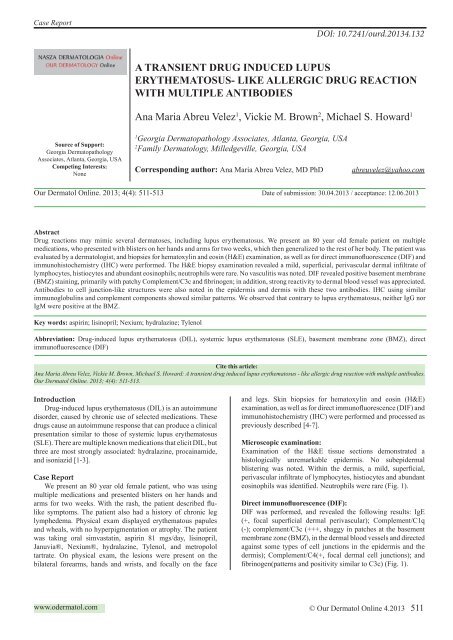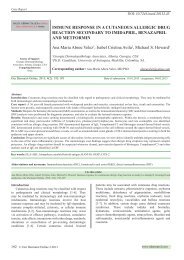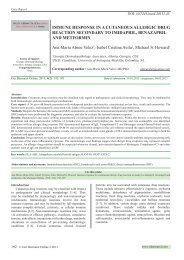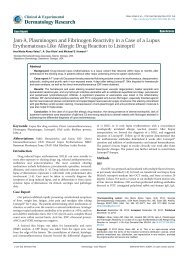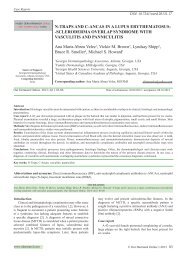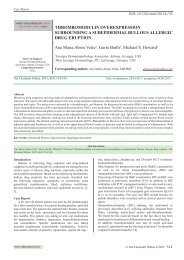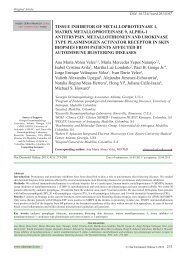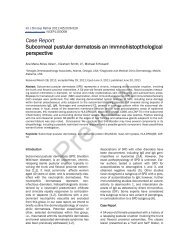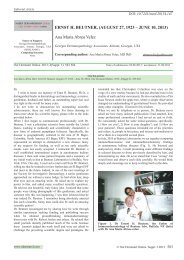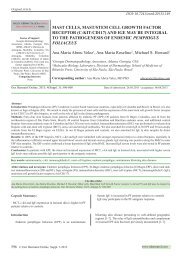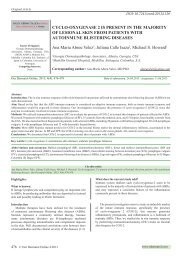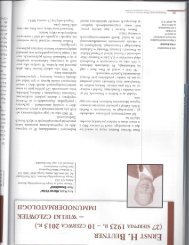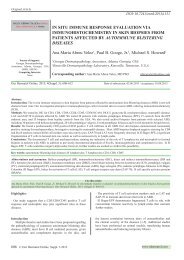o_195eh91k99gh1n6giap1kiojqva.pdf
Create successful ePaper yourself
Turn your PDF publications into a flip-book with our unique Google optimized e-Paper software.
Case Report<br />
DOI: 10.7241/ourd.20134.132<br />
A TRANSIENT DRUG INDUCED LUPUS<br />
ERYTHEMATOSUS- LIKE ALLERGIC DRUG REACTION<br />
WITH MULTIPLE ANTIBODIES<br />
Ana Maria Abreu Velez 1 , Vickie M. Brown 2 , Michael S. Howard 1<br />
Source of Support:<br />
Georgia Dermatopathology<br />
Associates, Atlanta, Georgia, USA<br />
Competing Interests:<br />
None<br />
1<br />
Georgia Dermatopathology Associates, Atlanta, Georgia, USA<br />
2<br />
Family Dermatology, Milledgeville, Georgia, USA<br />
Corresponding author: Ana Maria Abreu Velez, MD PhD<br />
abreuvelez@yahoo.com<br />
Our Dermatol Online. 2013; 4(4): 511-513 Date of submission: 30.04.2013 / acceptance: 12.06.2013<br />
Abstract<br />
Drug reactions may mimic several dermatoses, including lupus erythematosus. We present an 80 year old female patient on multiple<br />
medications, who presented with blisters on her hands and arms for two weeks, which then generalized to the rest of her body. The patient was<br />
evaluated by a dermatologist, and biopsies for hematoxylin and eosin (H&E) examination, as well as for direct immunofluorescence (DIF) and<br />
immunohistochemistry (IHC) were performed. The H&E biopsy examination revealed a mild, superficial, perivascular dermal infiltrate of<br />
lymphocytes, histiocytes and abundant eosinophils; neutrophils were rare. No vasculitis was noted. DIF revealed positive basement membrane<br />
(BMZ) staining, primarily with patchy Complement/C3c and fibrinogen; in addition, strong reactivity to dermal blood vessel was appreciated.<br />
Antibodies to cell junction-like structures were also noted in the epidermis and dermis with these two antibodies. IHC using similar<br />
immunoglobulins and complement components showed similar patterns. We observed that contrary to lupus erythematosus, neither IgG nor<br />
IgM were positive at the BMZ.<br />
Key words: aspirin; lisinopril; Nexium; hydralazine; Tylenol<br />
Abbreviation: Drug-induced lupus erythematosus (DIL), systemic lupus erythematosus (SLE), basement membrane zone (BMZ), direct<br />
immunofluorescence (DIF)<br />
Cite this article:<br />
Ana Maria Abreu Velez, Vickie M. Brown, Michael S. Howard: A transient drug induced lupus erythematosus - like allergic drug reaction with multiple antibodies.<br />
Our Dermatol Online. 2013; 4(4): 511-513.<br />
Introduction<br />
Drug-induced lupus erythematosus (DIL) is an autoimmune<br />
disorder, caused by chronic use of selected medications. These<br />
drugs cause an autoimmune response that can produce a clinical<br />
presentation similar to those of systemic lupus erythematosus<br />
(SLE). There are multiple known medications that elicit DIL, but<br />
three are most strongly associated: hydralazine, procainamide,<br />
and isoniazid [1-3].<br />
Case Report<br />
We present an 80 year old female patient, who was using<br />
multiple medications and presented blisters on her hands and<br />
arms for two weeks. With the rash, the patient described flulike<br />
symptoms. The patient also had a history of chronic leg<br />
lymphedema. Physical exam displayed erythematous papules<br />
and wheals, with no hyperpigmentation or atrophy. The patient<br />
was taking oral simvastatin, aspirin 81 mgs/day, lisinopril,<br />
Januvia®, Nexium®, hydralazine, Tylenol, and metropolol<br />
tartrate. On physical exam, the lesions were present on the<br />
bilateral forearms, hands and wrists, and focally on the face<br />
and legs. Skin biopsies for hematoxylin and eosin (H&E)<br />
examination, as well as for direct immunofluorescence (DIF) and<br />
immunohistochemistry (IHC) were performed and processed as<br />
previously described [4-7].<br />
Microscopic examination:<br />
Examination of the H&E tissue sections demonstrated a<br />
histologically unremarkable epidermis. No subepidermal<br />
blistering was noted. Within the dermis, a mild, superficial,<br />
perivascular infiltrate of lymphocytes, histiocytes and abundant<br />
eosinophils was identified. Neutrophils were rare (Fig. 1).<br />
Direct immunofluorescence (DIF):<br />
DIF was performed, and revealed the following results: IgE<br />
(+, focal superficial dermal perivascular); Complement/C1q<br />
(-); complement/C3c (+++, shaggy in patches at the basement<br />
membrane zone (BMZ), in the dermal blood vessels and directed<br />
against some types of cell junctions in the epidermis and the<br />
dermis); Complement/C4(+, focal dermal cell junctions); and<br />
fibrinogen(patterns and positivity similar to C3c) (Fig. 1).<br />
www.odermatol.com<br />
© Our Dermatol Online 4.2013 511
Fibrinogen and kappa light chain antibodies stained focal<br />
subcorneal areas. Epidermal cytoid bodies were observed, and<br />
demonstrated positive staining with IgM, fibrinogen, kappa<br />
light chains and complement/C3c. Antibodies to Ro/SSA-were<br />
positive, predominately with Complement/C3c. Anti-keratin<br />
antibodies were seen in the epidermis with IgM (Fig. 2).<br />
Immunostochemistry staining revealed similar findings to those<br />
seen by DIF, and also reactivity to dermal blood vessels with<br />
IgA (Fig. 1).<br />
Figure 1. a. H&E staining demonstrates a mild, superficial, perivascular dermal infiltrate (red arrow). b. DIF, demonstrating<br />
positive staining around dermal blood vessels with FITC conjugated fibrinogen(yellow staining; red arrow). c. Positive IHC<br />
staining with anti-human Complement/C3c in patches at the basement membrane zone (brown staining; red arrow) as well as<br />
around upper dermal blood vessels (brown staining; black arrow). d. IHC positive staining with anti-human IgA, around upper<br />
dermal blood vessels (brown staining; red arrow). e. H&E stain, demonstrating dermal infiltrate eosinophils(red arrows)(400X) f.<br />
DIF, demonstrating positive staining at the basement membrane zone with FITC conjugated C3c (yellow/green staining; red<br />
arrow). Epidermal keratinocyte nuclei were counterstained with Dapi (blue), and the upper layers of the epidermis were stained<br />
with rhodamine conjugated Ulex europaeus agglutinin(pink/red staining).<br />
Discussion<br />
Our patient was taking many medications that have been<br />
associated with DIL, and thus this diagnosis was favored given<br />
our pathologic findings. Clinically, DIL patients often report<br />
flu-like and joint discomfort symptoms. Our patient reported a<br />
chronic osteoarthalgia, and we could not determine if our DIL<br />
diagnosis contributed to this clinical problem. Additional signs<br />
and symptoms of DIL include myalgia, fatigue, pericarditis and/<br />
or pleuritis; in addition, positive anti-histone antibodies are<br />
noted in 95% of cases [1-3]. Our patient was negative for antihistone<br />
antibodies, but positive for antibodies against SS-A/Ro<br />
with Complement/C3c.<br />
In DIL, the lesions classically recede after discontinuing use of<br />
the eliciting drugs [1-3]. For therapy of our patient, Tacrolimus®<br />
1% cream was prescribed 3 times a day topically, as well as<br />
triamcinolone acetonide 0.1% topical cream. In recalcitrant cases<br />
of DIL, it may be also necessary to add systemic corticosteroids<br />
and/other immunosuppressive agents [3].<br />
Similar to expected findings in lupus erythematosus, we observed<br />
cytoid bodies with IgM antibodies. In addition, in our case we<br />
noted cytoid body antibodies with Complement/C3c, fibrinogen<br />
and subcorneal antibodies that are not classically described in<br />
lupus. We observed tissue fixed deposits of immunoglobulin M<br />
present in the cytoplasm of epidermal keratynocytes; however,<br />
instead of the 3 reported patters described in normal skin [8,9],<br />
our reactivity was present throughout the entire epidermis. Also<br />
remarkable was the reactivity to some type(s) of likely cell<br />
junctions in the epidermis and dermis, best appreciated with<br />
anti-Complment/C3c and fibrinogen.<br />
In conclusion, we note differences with classic lupus<br />
erythematosus in our case, including lack of an H&E interface<br />
dermatitis and the H&E presence of dermal eosinophils. Our<br />
case also features immunopathological features that differ<br />
from lupus; we noted positive antibodies to Ro/SSA, but with<br />
Complement/C3c. Further, in DIF and IHC our case differs from<br />
classic lupus due to a lack of linear deposits of IgG or IgM at<br />
the basement membrane zone, instead, patchy Complement/<br />
C3c and fibrinogen were observed. We also observed significant<br />
reactivity to dermal blood vessels, but no vasculitis as noted<br />
in selected classic cases of lupus. We also observed reactivity<br />
to several likely cell junctions in epidermis and dermis, whose<br />
nature remains unknown. Further studies utilizing sera against<br />
epidermal and dermal antigens may be helpful in characterizing<br />
these putative epitopes.<br />
512 © Our Dermatol Online 4.2013
Figure 2. a. DIF, demonstrating positive staining at the basement membrane zone with FITC conjugated Complement/C3c (yellow<br />
staining; red arrow); also note the multiple cell junction-like staining, visualized as small dots in the dermis and epidermis (yellow<br />
staining; white arrows). b. DIF, with positive staining against cytoid bodies with FITC conjugated anti-human IgM (yellow staining;<br />
red arrow). Also noted additional staining with this antibody as anti-keratin antibodies in the epidermis (ie, cytoplasmic antigens)<br />
(yellow staining; yellow arrow), as well as to some type of cell junction-like structures in the dermis (yellow staining; white arrow).<br />
c. DIF, showing positive staining within the epidermal stratum corneum with FITC conjugated Complement/C3c(yellow staining;<br />
yellow arrow). Epidermal keratinocyte nuclei were counterstained with Dapi (blue), and the upper layers of the epidermis were<br />
stained with rhodamine conjugated Ulex europaeus agglutinin. The white arrow highlights additional positive, focal staining<br />
against cell junction-like structures in the dermis (yellow staining). d. DIF, displaying positive staining with FITC conjugated antihuman<br />
fibrinogen, in a dermal perivascular distribution (yellow staining; red arrow); in addition, note the punctuate positive<br />
staining against cell junction-like structures in the dermis (yellow staining; white arrows).<br />
REFERENCES<br />
1. Hofstra A: Metabolism of hydralazine: relevance to drug-induced<br />
lupus. Drug Metab Rev. 1994.26:485–505.<br />
2. Marzano AV, Vezzoli P, Crosti C: Drug-induced lupus: an update<br />
on its dermatologic aspects. Lupus. 2009;18:935-40.<br />
3. Sarzi-Puttini P, Atzeni F, Capsoni F, Lubrano E, Doria A: Druginduced<br />
lupus erythematosus. Autoimmunity. 2005;38:507-18.<br />
4. Abreu Velez, AM, Klein AD, Howard MS: Specific cutaneous<br />
histologic and Immunologic features in a case of early lupus<br />
erythematosus scarring alopecia Our Dermatol Online. 2013;4:199-<br />
201.<br />
5. Abreu Velez, AM, Klein AD, Howard MS: Jam-A, plasminogen<br />
and fibrinogen Reactivity in a case of a lupus erythematosus-Like<br />
allergic drug reaction to Lisinopril. J Clin Exp Dermatol Res.<br />
2012;S:6.<br />
6. Abreu-Velez AM, Klein AD, Howard MS: Skin appendageal<br />
immune reactivity in a case of cutaneous lupus. Our Dermatol<br />
Online. 2011; 2:175-80.<br />
7. Abreu-Velez AM, Smith JG Jr, Howard MS: Activation of the<br />
signaling cascade in response to T lymphocyte receptor stimulation<br />
and prostanoids in a case of cutaneous lupus. North Am J Med Sci.<br />
2011;3:251-4.<br />
8. Ioannides D, Bystryn JC: Association of tissue-fixed cytoplasmic<br />
deposits of immunoglobulin in epidermal keratinocytes with lupus<br />
erythematosus. Arch Dermatol. 1993;129:1130-25.<br />
9. Bystryn JC, Nash M, Robins P: Epidermal cytoplasmic antigens:<br />
II. Concurrent presence of antigens of different specificities in normal<br />
human skin. J Invest Dermatol. 1978;71:110-3.<br />
Copyright by Ana Maria Abreu Velez, et al. This is an open access article distributed under the terms of the Creative Commons Attribution License,<br />
which permits unrestricted use, distribution, and reproduction in any medium, provided the original author and source are credited.<br />
© Our Dermatol Online 4.2013 513


